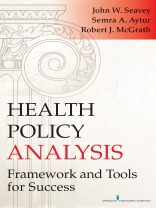This is the only resource to provide a step-by-step framework and expert guidance for preparing a policy analysis final paper or a capstone project for courses in health policy and health policy analysis. Building on a blend of theory and political considerations for creating a successful policy analysis, the text guides students through the process of building an analysis that encompasses policy background, issue statement, normative and stakeholder analysis, criteria for success, systematic review of policy options, recommendations, and a strategy for adoption. To illustrate each step of the process, the text traces the development of a policy on childhood obesity, the framework of which is directly applicable to a broad spectrum of policy analysis projects.
The text explains why each component of the health policy analysis framework is important and includes concrete guidance for obtaining resources and requisite tools for completing each task. It emphasizes the need for both objective research and the ability to understand the perspectives of stakeholders as well as the potential strengths, weaknesses, and biases of various sources. The book underscores the importance of considering alternatives in making policy recommendation a reality. Additionally, it focuses on understanding political realities and policy process to successfully navigate the system. Breakout boxes feature state-of-the-art examples to demonstrate the frameworkís application. The book also includes chapter summaries to reinforce the material and questions to spur further thought. The authors are health professionals connected nationally to relevant groups (e.g., AUPHA, APHA, Robert Wood Johnson, and environmental health policy groups), and have extensive networks in practice and academia.
Key Features:- Builds on a blend of theory and political considerations to create a successful policy analysis
- Provides a step-by-step framework for constructing a health policy analysis with real world application
- Integrates a variety of disciplines into the policy analysis
- Traces the development of a policy on childhood obesity to illustrate each step of the process
- Offers viable solutions to questions and issues students struggle with while preparing their analysis
Tabela de Conteúdo
Preface
Acknowledgments
Chapter 1. Perspectives for Public Health Policy Analysis
Determinants of Public Health
Core Functions of Public Health
Health in All Policies (Hi AP)
Summary
Chapter 2. Elements and History of the US Political Structure
The Need for Political Structure
The Economic System and Market Failure
Policy & Law
American Historical Perspectives
The Articles of Confederation & the Constitution
General Structural Principles
Separation of Powers
Federalism
Medicare/Medicaid and Affordable Health Care
Delegated Powers
Implied Powers
Summary
Chapter 3. The United States’ Political Structure
The Preamble
The Legislative Branch
State Legislatures
The Executive Branch
The President
The Federal Bureaucracy
The Office of the President
The Cabinet
The Civil Service
State Executives
The Judicial Branch
The Federal Court System
The State Court Systems
Remaining Constitutional Provisions
The Bill of Rights
Freedom of Religion
The Second Amendment
The 9th Amendment
Summary
Chapter 4. The Political Process
The Policy Making Process
Procedural Democracy and Constitutional Democracy
Democracy and Democratic Pluralism
Factions
Special Interest Groups & Lobbying
Scope and Bias
The Ability to Block
Political Parties
Incrementalism
US Political Process Defined
Summary
Chapter 5. The American Maze
The Legislative Process
Staff
Legislative Committees
Introduction of a Policy Proposal
Rules and Regulations
Executive Orders
The Judiciary
States & Local Governments
Summary
Chapter 6. Political Culture
The Nature of Political Culture
Examples of the Dominant American Political Culture
Non-Partisan Efforts
Partisanship
States and Local Political Cultures
Summary
Chapter 7. Beginning your Public Health Policy Analysis
A Roadmap for Writing a Policy Analysis Report
Consideration of Political Science Theory
Assessing the Evidence
Peer Reviewed Literature
Grey Literature
Engaging Key Stakeholders
Some Specifics for Writing Your Report
Table of Contents
Executive Summary
Definitions/Abbreviations
References
Other Appendices
Summary
Chapter 8. Health Policy Analysis Foundations
Health Policy and Health Services Research
Health Policy Analysis
Evidence-Based Health Policy
Effectiveness
Efficiency
Allocative and Production Efficiency
Equity
Feasibility
Integrative Frameworks
PRECEDE-PROCEED
RE-AIM
National Efforts of Health Policy Analysis
Agency for Healthcare Research & Quality (AHRQ)
The National Academy of Medicine (NAM); formerly The Institute of Medicine (IOM)
Patient-Centered Outcomes Research Institute (PCORI)
Centers for Disease Control and Prevention (CDC)
The CDC Policy Research, Analysis, and Development Office
Other Policy Research Institutes
Summary
Chapter 9. Health Data and Analytical Methods
Public Data
Analytical Studies
Performing the Analysis
The Data Ecosystem
General Analytic Functions
Artificial Intelligence (AI) and “Big Data”
Tools
The Unintended Impacts of Data Science Methods for Policy Analysis
Data Gaps and their Biases
Final Considerations
Summary
Chapter 10. Policy Background Section
History
The Obesity Issue
Policy Significance
Legal Authority/Flexibility
Model Programs/Policies
Relationships to Other Policy Issues
Policy Agenda
Summary
Chapter 11. Statement of Policy Issue
Policy Issue Statement
What Does a Policy Issue Statement Look Like?
Framing
Summary
Chapter 12. Stakeholder Analysis
The Role of Values
Example of Stakeholders in Child Obesity
Stakeholder Analysis
Tools for Stakeholder Analysis
LFHK Washington State
Summary
Chapter 13. Criteria for Success
Definition of Success
Measurement
Summary
Chapter 14. Review of Policy Options
Evidence
When to Call It Quits
Summary
Chapter 15. Recommendation and Strategies
Recommendation
Legislative Strategies
Administrative Strategies
Litigation Strategy
Summary
Appendix
Sobre o autor
Semra A. Aytur, Ph D, MPH is an epidemiologist and Professor in the Department of Health Management and Policy at the University of New Hampshire.












